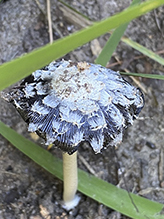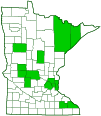Magpie Inkcap
(Coprinopsis picacea)
Conservation • Description • Habitat • Ecology • Distribution • Taxonomy
Conservation Status |
|
|||||||
| IUCN Red List | not listed |
|||||||
| NatureServe | NNR - Unranked |
|||||||
| Minnesota | not listed |
|||||||
Description |
||
Magpie Inkcap is a widespread, easily recognized, short-lived, gilled mushroom. It occurs in Europe, North America, Australia, and southern Africa. In the United States it occurs east of the Great Plains and west of the Rocky Mountains, but is mostly absent between. It is widespread but not common. It is found from May to November, usually alone, sometimes in small, well-spaced groups, in deciduous forests and woodlands. It grows on the ground under oak trees. When it first appears the cap is cyllinder-shaped or oval, brown, and covered with whitish material of the universal veil just beginning to break up. A young cap can easily be mistaken for Shaggy Mane. As it ages it spreads out and the veil material breaks up into separate patch-like scales. At this stage it is said to resemble the plumage of the Eurasian Magpie. This is the feature that gives the mushroom its common name. The mature cap is broadly bell-shaped, glossy, very dark grayish-brown, and 1¼″ to 3″ (3 to 8 cm) in diameter. It is finely lined (striate) from the margins all the way to the center. The margins eventually bend outward and liquefy (deliquesce), turning to ink. The stalk is white and is covered with small patches of white woolly hairs (floccose). It can be 2¾″ to 10″ (7 to 25 cm) long and 3⁄16″ to ⅝″ (5 to 15 mm) thick, but it is usually no more than 6″ (15 cm) long. The base is usually slightly enlarged (bulbous) and covered with woolly hairs. There is no partial so there is no ring on the stalk. The gills are crowded and may be broadly attached to the stalk (adnate) or not at all attached to the stalk (free). They are white at first, turning reddish as they age. At maturity they turn black and liquify into ink that drops to the ground. This is the feature that gives the genus its common name. The flesh is thin, fibrous, watery, and inedible. It has a unpleasant odor and taste, and causes digestive upset in some people. The spore print is black. |
||
Similar Species |
||
Habitat and Hosts |
||
Deciduous forests and woodlands |
||
Ecology |
||
Season |
||
May to November |
||
Distribution |
||||
|
Sources |
|||
| 10/8/2022 | ||||
Occurrence |
||||
Widespread but not common |
||||
Taxonomy |
|||
Kingdom |
Fungi (Fungi) |
||
Subkingdom |
Dikarya |
||
Phylum |
Basidiomycota (Basidiomycete Fungi) |
||
Subphylum |
Agaricomycotina (Higher Basidiomycetes) |
||
Class |
Agaricomycetes (Mushrooms, Bracket Fungi, Puffballs, and Allies) |
||
Subclass |
Agaricomycetidae |
||
Order |
|||
Suborder |
Agaricineae |
||
Family |
Psathyrellaceae (brittlestems and allies) |
||
Genus |
Coprinopsis (inkcaps) |
||
Section |
Picaceae |
||
Magpie InkCap was previously classified as Coprinus picaceus in the family Agaricaceae. A molecular DNA study published in 2001 showed that most of the species in the genus Coprinus were only distantly related to the type species Coprinus comatus. All but three species were moved to the new family Psathyrellaceae and assigned new genera. |
|||
Synonyms |
|||
Agaricus picaceus Coprinus picaceus |
|||
Common Names |
|||
Magpie Inkcap Magpie Inkcap Fungus Magpie Inky Cap Magpie Mushroom |
|||
Glossary
Universal veil
An egg-like structure that envelopes all or most of a developing gill mushroom. Remnants of the universal veil sometimes visible on a mature mushroom are patchy warts on the cap, a ring on the stalk, and a volva at the base of the stalk.
Visitor Photos |
|||||
Share your photo of this fungus. |
|||||
| This button not working for you? Simply email us at info@MinnesotaSeasons.com. Attach one or more photos and, if you like, a caption. |
|||||
Monette Lundquist |
|||||
Found this in my flower garden in Becker County. Never have seen anything like it. |
|||||
 |
|||||
MinnesotaSeasons.com Photos |
|||||
|
|||||

Slideshows |
||

Visitor Videos |
|||
Share your video of this fungus. |
|||
| This button not working for you? Simply email us at info@MinnesotaSeasons.com. Attach a video, a YouTube link, or a cloud storage link. |
|||
Other Videos |
|||
| Coprinopsis picacea, Coprinus picaceus, Magpie Inkcap, Šarena gnojištarka, Le Coprin pie 4k The wonderful world of mycology |
|||
About
Oct 27, 2021 In one of the outings to see species with my companions Verónica, Cadiñanos and Iosi we found several species, among them this beautiful coprinus. For me the most elegant of them all, and also, on this occasion we were able to see many, which is difficult. If you ever find it, take a picture of it, but leave it there. Coprinopsis picacea (Bull.) Redhead, Vilgalys & Moncalvo 2001 Characteristics: Confusions: It is difficult to confuse it with other coprinus |
|||
| Shaggy inkcap mushroom growing on forest floor time lapse. Coprinopsis picacea. Magpie inkcap Neil Bromhall |
|||
About
Premiered Oct 17, 2019 Shaggy ink cap mushroom 'Coprinopsis picacea' growing time lapse. Filmed by Neil Bromhall. Filmed in my studio. I dressed a set to look like a woodland floor. The inkcap liquifies as it matures. Slugs eat the spores and transport them through the forest. Filmed over two days. Cameras used Nikon Music 'Enchanted Journey' by Kevin MacLeod |
|||
| Coprinopsis picacea coprinus picaceus nikos baxes |
|||
About
May 4, 2019 |
|||

Visitor Sightings |
|||||
Report a sighting of this fungus. |
|||||
| This button not working for you? Simply email us at info@MinnesotaSeasons.com. Be sure to include a location. |
|||||
| Monette Lundquist 9/30/2022 |
Location: Becker County Found this in my flower garden in Becker County. Never have seen anything like it. |
||||
MinnesotaSeasons.com Sightings |
|||||
|
|||||

Created: 10/8/2022
Last Updated:

